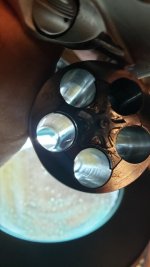DirtyHarold
New member
If you own an SP101, with the cylinder open and unloaded shine a light at the firing pin (to illuminate the inside of the barrel) and look down the barrel from the muzzle end and see if you can see any faint looking ring shaped impressions in your barrel.
I'm not talking like scratches, just faint almost scuff like ring shapes on mostly the lands but also partially the grooves.
I just notices this in my SP the other day. Dont really notice anything in the GP100. Just wondering if any other SP's have the same thing.
I would post pics but cant get a good in focus one. theyre all totally worthless.
I'm not talking like scratches, just faint almost scuff like ring shapes on mostly the lands but also partially the grooves.
I just notices this in my SP the other day. Dont really notice anything in the GP100. Just wondering if any other SP's have the same thing.
I would post pics but cant get a good in focus one. theyre all totally worthless.


